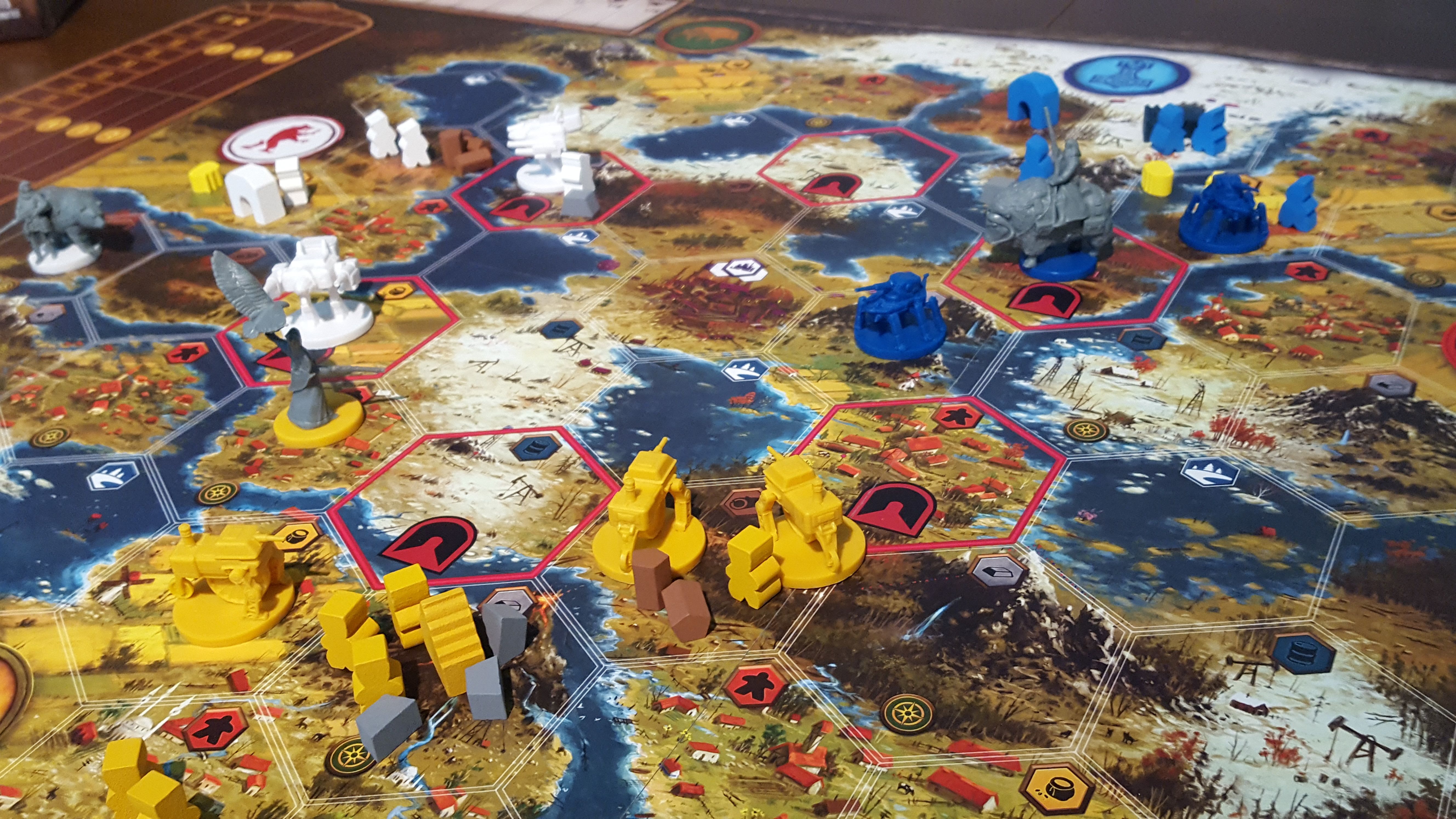Scythe Review
June 29, 2017
At it’s heart, Scythe is a resource management game. Those resources are depicted on a game board comprised of hexagonal territories. Each hex producing one of four resources. Villages produce more workers to further production, farms produce food for recruits, forests produce wood for structures and mountains produce metal for mechs. Yay mechs!
Each player randomly receives a faction mat and a player board, and sits near their faction’s home territory. Each faction always starts in the same location, meaning they will have immediate access to the same three resource types every game. The player board is the driving mechanic behind the game. Divided into four vertical sections, it contains four top row actions paired with four bottom row actions.
Top row actions are:
move figures – up to two figures may move one hex
trade resources – pay one coin to gain any combination of two resources
produce resources – all workers on up to two hexes produce one resource each of the
type depicted on the hex
bolster power – gain two power on the power track
Bottom row actions are:
upgrade actions – move one technology cube from any top row action to any bottom row
action, decreasing costs and increasing benefits
build structures – choose any structure from your player board and place it in a hex with
a worker
deploy mechs – choose any mech on your faction mat and place it in a hex with a worker
recruit – remove a recruit token from your player board to gain an immediate benefit
Each player board differs in the pairing of these top and bottom row actions. One player may choose the top row action to move, which is paired up with the bottom row action to build a structure.The next player in turn order may also chooses to move, but their bottom row action is to deploy a mech.
Speaking of mechs, they can take part in combat if an opponent has control of a territory that produces a type of resource you want, or if they already have resources that you want to try and steal. This is where the bolster action helps out. Each player takes a power dial and secretly chooses to spend zero to seven power, never exceeding the amount of power they currently show on the power track. Each player can also choose to secretly add a combat card per plastic figure they have in the combat. Workers, which are wooden, do not aid in combat. The player with the highest total power wins the combat and any resources that might be on that tile. The losing player retreats, their units returning to their faction’s home territory. If the defending player had any workers in the attacked space, the attacking player would lose one popularity from the popularity per worker in that space. More on this later.
Players continue choosing a set of actions to perform each turn, with the ultimate goal of earning six stars to trigger end game scoring, and to be the one with the most money once that has happened. Players earn stars by winning combat, deploying all mechs, building all structures, recruiting all recruits, paying for all upgrades, completing one of two hidden objective cards that are randomly handed out at the start of the game, having all workers on the board, reaching the end of the power track and reaching the end of the popularity track. Once a player has earned their sixth star, final scoring begins.
Where each player is on the popularity track will dictate how much money players will earn for: number of controlled hexes, number of stars earned, and number of resources controlled on the board. The higher you are on the popularity track, the more money each category will earn you. The player with the most money is declared the winner.
Impressions:
I remember when this game was originally on Kickstarter, you couldn’t put in an earbud without hearing about it on every board game podcast at the time. The hype was pretty unreal, and this game was MADE for Kickstarter. With its cool plastic mechs, great artwork depicting a dystopian, alternate world, touting itself as a 4X(explore, expand, exploit, exterminate) game. It hit all the right notes to appease the pledge gods, and good on Stonemaier games for taking their extensive KS experience and making the most of it. In fact, Jamey Stegmaier has tons of tips and advice on all things Kickstarter and is more than happy to share his experiences using the platform to help others looking to break into the industry as well. Can find that info at stonemaiergames.com.
When this game fully funded and the KS ended, I immediately regretted not backing it. Which is no surprise really, Stonemaier games are great, I’m a big fan of Viticulture and Euphoria. So I was happy as hell when it finally came back in stock for a reasonable price and I could get my hands on a copy. For me, this game definitely lived up to my expectations. It’s strangely addicting, always kind of floating around in the back of my brain. Never giving me the shakes if I don’t play it for awhile, but every time I look at it on my shelf it’s blocky box just beckons to me and I can’t help but grab it before anything else right now. A huge part of that is the variability that’s built into the game. Not just the asymmetric faction powers(always a good thing), but the combination of a random player board with different action pairings, and action costs, make every play slightly different. And in this game, slightly different goes a long way towards changing a player’s overall strategy, and how to best utilize their faction’s power.
Starting as Crimean Khanate, with immediate access to a farm, village and mountain but desperately need wood to build your Mill? Load up some workers on that mountain and pump out enough metal to build your riverwalk mech and scavenge resources further away from your home territory. Playing as the Nordic Kingdom and need to accelerate your production? Well just use your faction power and send those swimming workers to a village and start making people! This constant variance in every playthrough keeps the puzzle of the game from getting stale. There’s one way you win this game, and that is efficiency. If you’re able to take the top AND bottom row actions every time you’re taking a turn, you’re going to succeed.
The biggest criticism for Scythe that pretty much everybody agrees on, is the lackluster combat system. Compared to the meaty action efficiency puzzle, there isn’t much substance to the combat. Pick a combat card, spend some power, high number wins, loser retreats. Badda bing, badda boom. I’ve rarely seen the game end with any player having more than one combat star (you can earn up to two), even when Saxony Empire is in the game. Part of their power is that they can earn unlimited stars for combat. I agree that the system itself isn’t very exciting, and you have all these cool mechs stomping around the board and they barely engage. But I think the coolest part of the combat IS the lack of it. Each player’s mech serves as a nuclear deterrent to other players, enforcing established borders on the map and protecting your workers and resources so you can keep your engine moving. This comes into play mostly by mid to late game, when everybody has three to five stars on the board. The game begins to crescendo as each player is racing to hit their sixth star first; a combat win could let them pull ahead. And then just one more building and the game is over! But oh shit, if they LOSE, all that momentum goes to their opponent and they’re screwed! It can put players in a risky situation, forcing them to make a difficult decision, which is awesome.
Another thing to consider for combat is, of course, how much power a player has. This is another interaction that causes players to make an interesting decision, since reaching the end of the power track is one of ten ways to earn a star. You may want to engage with another player to try and drain their power, but you still don’t want them to win the combat, so you have to invest your power as well. Which puts you further away from gaining that power track star too. I think the combat system can be very nuanced, a simple tool to be wielded in complex situations.
That last statement sums up this whole game for me. Players are repeatedly making small, but impactful, decisions every time they take an action. Sometimes the action’s impact isn’t apparent until three or four turns later, but it’s easy to see what you could have done better and learn from it for future plays. And I guarantee that you will want future plays. The fact that these decisions are small and not always apparent is what makes this game accessible to a wide range of people. The basic concepts are not difficult to grasp, new players can pick them up quite easily in my experience (except for my little brother, he REALLY sucks at this game, I kill him every time, seriously, he is so fucking bad).
If you’re in a similar situation to me, then you might not be able to get a gaming group together as often as you’d like, but fear not despondent gamer! Scythe has a solo variant you can play! I’ve played this about half a dozen times now and have easily won every play. But that’s, of course, because I was playing it wrong and not moving the AI player’s pieces properly. So be wary of that, the rules seem a little unclear at first, but make all the sense in hindsight. Aside from that, the solo play is pretty comparable to the multiplayer play in my opinion. You still get to try and figure out the efficiency puzzle, and you’re still on a clock that isn’t solely dictated by your own play. All in all, it’s good filler between getting a play group together.
L.
